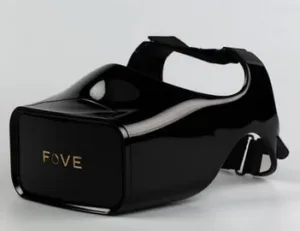Fove, Inc. a Tokyo-based startup with offices in San Francisco, is developing a consumer VR headset that includes eye-tracking technology. This feature is intended to give the user an “immersive and completely hands-free virtual reality, where all of their actions can be controlled by their eye movements.”
The Fove headset enables eye-tracking by incorporating two small cameras and custom infrared sensors into the headset. Infrared light is bounced off the retina to track the user’s eye movements and to determine how the user’s eyes are angled. From this information, proprietary algorithms are used to calculate the parallax between the eyes and to track and measure depth-of-field focus.
Tracking the user’s gaze and calculating where in 3D space the user is looking enables so-called foveated rendering. This capability allows the graphics engine to adjust focus and appropriately allocate rendering resources. By doing so, it is possible to drastically reduce the computing power required to deliver realistic imagery. It is expected that conserving computational power will allow the headset to be used with a wide range of devices extending from PCs to smartphones.
At present, users perform a short calibration sequence, during which the system scans the user’s eye and tracks the movement of their iris. The team reports the intention that the next version of the device will use iris recognition to load user profiles.
In general, gazed tracking can allow the user to auto-target with a glance and initiate contextual interactions. As a separate matter, the company also believes that it will reduce simulation sickness by minimizing the need for unnatural head movements.
Games are an initial product target for Fove. In such applications, when the user makes eye contact, “watched” characters can now be made to behave and react differently.
Beyond games, the makers of Fove say the device could also bring virtual reality to cinema, allowing headset wearing viewers to interact with objects and characters. The headset is also believed suitable for education, training, research, psychology and neuroscience. In health care-medical applications, VR can be used to provide a new form of expression for the physically disabled. The user’s eyes could, for example, be used to manipulate the UI to type or operate robots.
A viedo of the headset in operation can be found at the end of this article.
Some specifications for the eventual Fove headset include:
- 5.8-inch screen with a resolution of 2560×1440
- 100o field of view
- 60 FPS
- Two IR tracking systems with 0.2o accuracy and a frequency of 120 fps per eye
- Headset weight is 400 g
The company is currently involved in a Kickstarter fund raising campaign. At the time this article is written, the company has raised $230,228 from 564 backers towards a goal of $250,000. The campaign is scheduled to close on July 3rd so success seems certain. Fove plans to use funds raised by the campaign to refine its eye tracking technology so that it works equally well on people with faces and eyes of all sizes and shapes. The company is also checking the safety of infrared lights used in the headset. It is reported that head position tracking capability is in development and will be available by the time headsets are shipped.
The company is currently demonstrating headsets to the public. The headset is now available for pre-order on Kickstarter with delivery scheduled for May 2016. This delivery timeline is believed realistic because Fove has “hands-on support” from Toshiba and Samsung, which are providing components including displays. The anticipated retail price of the Fove headset will be in the range of from $400 to $500. A SDK is expected to be released early next year. – Arthur Berman

